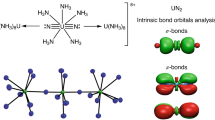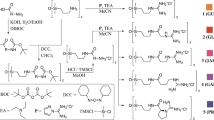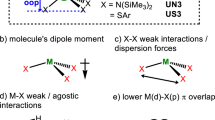Abstract
X-RAY crystallographic data1,2 indicate that in solid uranyl salts and metallic uranates the UO2++ ion is linear, and if this configuration is retained, only one frequency corresponding to the symmetric ν1 vibration should appear in the Raman spectra of uranyl salt solutions. Actual observations3–5, however, have shown at least two fundamental frequencies, at about 860 cm.−1 and 200 cm.−1, which have been assigned to the symmetric ν1 and bending ν2 vibrations respectively. Satyanarayana4 found also a weak line at 909 cm.−1, corresponding to the asymmetric ν3 vibration. These results suggest that the UO2++ ion in solution is bent, a conclusion supported by the infra-red spectral measurements, in which the ν1 frequency, forbidden for a linear model, has always been observed. Both Crandall5 and Satyanarayana have suggested that the ion might be linear in solution, local forces being responsible for the appearance of forbidden frequencies in the spectra. Hitherto, no experimental evidence has been put forward in support of this contention.
This is a preview of subscription content, access via your institution
Access options
Subscribe to this journal
Receive 51 print issues and online access
$199.00 per year
only $3.90 per issue
Buy this article
- Purchase on Springer Link
- Instant access to full article PDF
Prices may be subject to local taxes which are calculated during checkout
Similar content being viewed by others
References
Fankuchen, I., Phys. Rev., 43, 327, 536 and 1048 (1933); Z. Krist., 91, 473 (1935).
Zachariasen, W. H., Acta Cryst., 1, 277 and 281 (1948).
Conn, G. K. T., and Wu, C. K., Trans. Farad. Soc., 34, 1483 (1938).
Satyanarayana, B. S., Proc. Ind. Acad. Sci., 15A, 414 (1942).
Crandall, H. W., J. Chem. Phys., 17, 602 (1949).
Kolthoff, I. M., and Harris, W. E., J. Amer. Chem. Soc., 68, 1175 (1946).
Sutton, J. (unpublished work).
Betts, R. H., and Michels, Rita K., J. Chem. Soc., Supp. 2S, 286 (1949).
Sutton, J., J. Chem. Soc., Supp.2S, 275 (1949).
Kaplan, L., Hildebrandt, R. A., and Ader, M., U.S. Atomic Energy Commission Reports ANL. 4520 and 4521.
Author information
Authors and Affiliations
Rights and permissions
About this article
Cite this article
SUTTON, J. Configuration of the Uranyl Ion. Nature 169, 235–236 (1952). https://doi.org/10.1038/169235b0
Issue Date:
DOI: https://doi.org/10.1038/169235b0
This article is cited by
-
Adsorption of uranium onto amidoxime-group mesoporous biomass carbon: kinetics, isotherm and thermodynamics
Journal of Radioanalytical and Nuclear Chemistry (2022)
-
The influence of amine templates on the structures and properties of uranyl oxalate complex
Journal of Radioanalytical and Nuclear Chemistry (2021)
-
Electronic transitions of uranyl ion
Proceedings of the Indian Academy of Sciences - Section A (1969)
-
Raman spectra of solutions of uranyl compounds
Journal of Applied Spectroscopy (1966)
-
The absorption and fluorescence spectra of uranyl nitrate solutions at room temperature
Proceedings of the Indian Academy of Sciences - Section A (1959)
Comments
By submitting a comment you agree to abide by our Terms and Community Guidelines. If you find something abusive or that does not comply with our terms or guidelines please flag it as inappropriate.



